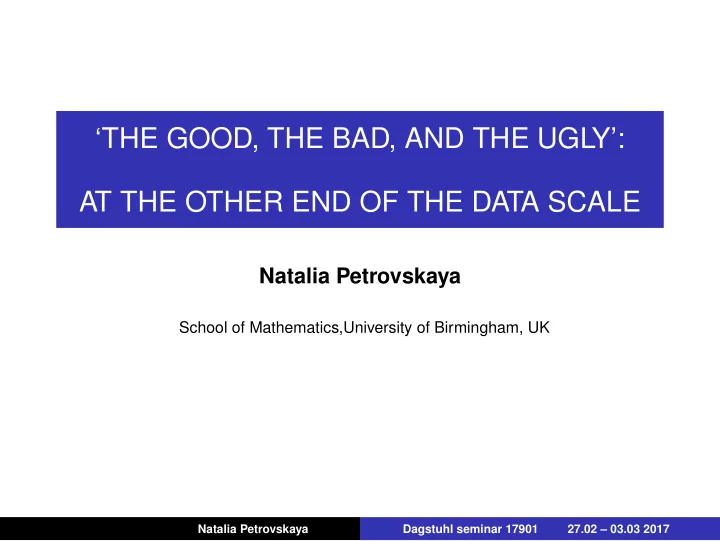

‘THE GOOD, THE BAD, AND THE UGLY’: AT THE OTHER END OF THE DATA SCALE Natalia Petrovskaya School of Mathematics,University of Birmingham, UK Natalia Petrovskaya Dagstuhl seminar 17901 27.02 – 03.03 2017
Personal background • Applied mathematician: MSci – National Research Nuclear University (MEPhI), Russia, PhD - Keldysh Institute for Applied Mathematics (KIAM), Russia. • researcher in KIAM – computational aerodynamics (contractor for Boeing) and computational plasma physics (contractor for National Research Center ‘Kurchatov Institute’). • from 2004: lecturer, senior lecturer at University of Birmingham, UK – mathematical ecology. Natalia Petrovskaya Dagstuhl seminar 17901 27.02 – 03.03 2017
Research Areas/Interests • Efficient computational methods for pest monitoring and control: – the problem of uncertainty and accuracy control for strongly heterogeneous spatial ecological data – evaluation of the population density functionals (the total population size, synchronization between habitats) from sparse ecological data – evaluation of the total population size from noisy ecological data Natalia Petrovskaya Dagstuhl seminar 17901 27.02 – 03.03 2017
Research Areas/Interests • Mathematical models for biological invasion – various regimes of biological invasion: short-distance dispersal vs. long-distance dispersal – patchy invasion scenario: pattern formation • Spatio-temporal dynamics of slug population (applied project with ecologists at Harper Adams University, UK) – predictive modelling (individual based modelling, partial differential equations) – processing field data Natalia Petrovskaya Dagstuhl seminar 17901 27.02 – 03.03 2017
Links to ‘Computer Science meets Ecology’ • What happens at the other end of the data scale (big data vs. sparse data) – Does ‘big data’ always mean ‘reliable data’? – How to measure the quality of information (sparse � = noisy)? – Transition from sparse to big datasets - threshold quantities? Natalia Petrovskaya Dagstuhl seminar 17901 27.02 – 03.03 2017
Links to ‘Computer Science meets Ecology’ • Pattern recognition problem (spatial clusters, heterogeneous spatial density distributions...) – Resolution of spatial pattern features? – Automated recognition of spatial clusters, evaluation of the cluster size? – Automated recognition of invasive fronts/patches? Natalia Petrovskaya Dagstuhl seminar 17901 27.02 – 03.03 2017
Recommend
More recommend